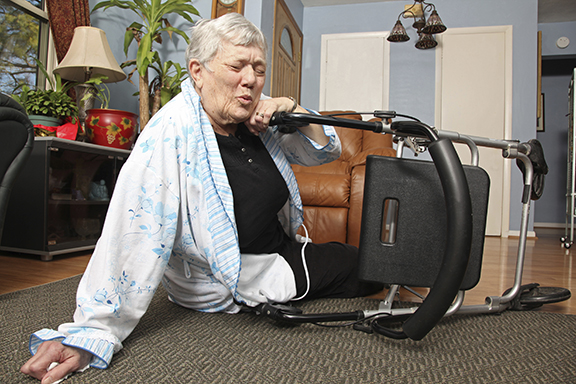Senior Safety: Preventing Falls

Every year, one in three Canadian seniors experiences a fall. Half of them will fall more than once.*
These statistics are alarming on their own, but there’s more:
The impact of a fall can linger long after the initial scrapes and bruises have healed. In fact, the effects of falls are often farreaching and devastating. “For many older adults, a fall is the beginning of a downward spiral,” says Anna Cooper, Clinical Practice Leader/BPSO Lead at Bayshore HealthCare. “It can trigger a series of other things – hospitalization, surgery, loss of independence. Even if injuries aren’t serious, a fall can cause people to lose confidence and limit their activities. Their quality of life suffers, and other health problems may develop or worsen. You wouldn’t think one fall could do that, but we’ve seen it time and time again – it’s typically the event that completely changes the picture for seniors.” Many Canadians don’t realize how serious the consequences of a fall can be, adds Katie Schinkel, an occupational therapist and Director of Therapy & Rehab at Bayshore Therapy & Rehab. “People aren’t aware that a serious fall can lead to complete dependence, with seniors ending up in a long-term care facility because they can’t go home again.” Falls can create stress and financial hardship for seniors and families, and they have a high cost for Canada’s health system, too: each year, they incur $2 billion in direct health care costs.
Risk factors for falls
Falls are preventable. Understanding why they happen can help seniors and their families take action to improve safety – especially since half of seniors’ injuries occur at home. There are many common factors that increase the likelihood of falls:
- Age (risk increases as we grow older)
- History of falls
- Lack of physical activity (often linked to a fear of falling)
- Decreased bone and muscle strength
- Reduced vision and hearing
- Poor balance or gait problems
- Cognitive conditions
- Poor nutrition or skipping meals
- Medical conditions or treatments that cause fatigue, dizziness, weakness, impaired balance, mobility problems
- Getting up at night to use the bathroom
- Excessive alcohol intake
- Living alone
- Chronic foot problems
- Footwear and clothing that interfere with movement
- Weather (ice, snow)
- Unsafe conditions inside or outside the home (tripping hazards such as rugs, cords, furniture and pets; slippery or uneven floors; poor lighting in hallways, stairs or entrances; clutter; climbing to reach objects on high shelves, general disrepair)
- Not using ambulatory aids (canes, walkers)
- Not using safety aids (glasses, hearing aids)
- Lack of safety and mobility aids (grab bars, railings)
*Public Health Agency of Canada
For more information about preventing falls, read “Healthy Steps”, a helpful guide from Bayshore HealthCare’s OptimaCuraTM Clinical Programs.
To get your copy of Healthy Steps, please email clientservice@bayshore.ca
